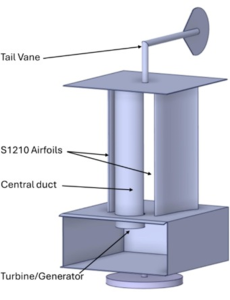December 23, 2025
CFK will be closed December 18 - January 4. Happy Holidays!
CFK faculty advance urban wind energy technology
Two faculty members from The College of the Florida Keys (CFK) have co-authored research that could transform how cities harness wind energy. Dr. Muhammad I. Hussain from the Department of Engineering Technology and Dr. Patrick Rice from the Office of Science & Research recently published the findings in the journal Energy Conversion and Management: X.
Drs. Hussain and Rice were among a team of scientists who studied a special type of wind turbine that does not have spinning blades like conventional wind turbines. Instead, it uses two curved pieces called airfoils that sit across from each other. When wind blows over these pieces, it creates a vacuum and a suction that pulls air through the middle and spins a generator to make electricity. The findings showed promise for quieter, safer wind turbines ideal for installation on rooftops in urban areas.
Pictured Left: Heat map of velocity contours showing air speed (red being the fastest moving) through airfoils (curved white shapes) of the motionless wind turbine. The airfoils create the suction effect. Pictured Right: A 3D prototype rendering of a wind turbine with airfoils.
"This technology addresses a major challenge in urban wind energy," said Dr. Hussain. "Traditional wind turbines are too large and noisy for city use, but our research shows these motionless systems have the potential to be a game-changer."
The research team discovered that while these turbines are promising, they lose up to 81% of their power when wind doesn't blow directly at them. To resolve this critical problem, they tested five different tail shapes and found one of the specially designed tail vanes helped keep the turbine aligned with changing wind directions better than the others. The airplane wing-shaped tails performed 15% better than other designs, enabling the turbines to capture maximum wind energy even in variable urban wind conditions.
These wind systems can generate power 24/7 and continue working in snow and rain, potentially producing more annual energy than equivalent solar installations.
To read the full article, visit ScienceDirect


